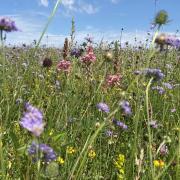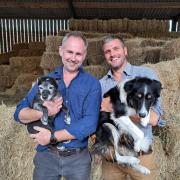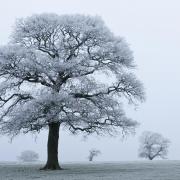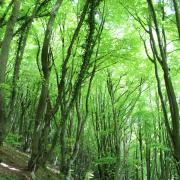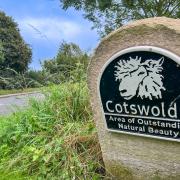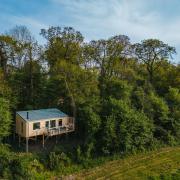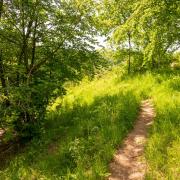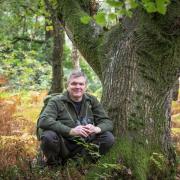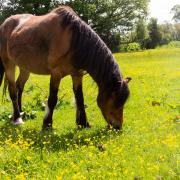What does conservation work look like in autumn? As autumn approaches, it may feel like wildlife is winding down, but the work to care for the county’s wild places ramps up for Gloucestershire Wildlife Trust
Hedgerows are bustling with life as berries ripen, leaves start changing colour, fungi begin to flourish, and incredible migrations of birds, fish, amphibians and even insects are taking place.
But as the days begin to shorten, most wildlife that dwells in the UK year-round starts to prepare for the colder months by entering a period of dormancy or hibernation.
The same can’t be said for the land management team and volunteers at Gloucestershire Wildlife Trust.

‘Autumn is the best time to carry out certain tasks,’ says Del Jones, Lead Land Manager West.
‘By doing as much as possible when most wildlife is dormant, the Trust’s staff and volunteers are ensuring a more resilient and diverse habitat for them when they wake back up.’
Species-rich grasslands and meadows are left throughout the summer so even the later flowering species like Devil's-bit scabious have time to set seed before hay cutting begins. This has the dual benefit of encouraging wildflowers to come back bigger and better each year, but also as a crucial nectar source for pollinators when their supplies start to dwindle.

In autumn, the Trust’s hardy herds of sheep, cattle and ponies will be back out on reserves around the county. An essential part of the team, they act as a form of natural grassland management, pushing seeds into the ground with their hooves and providing nutrients in their manure.
‘Conservation grazing livestock are critical to not only grassland management, but also for wetlands and heathlands,’ says Del. ‘Specific breeds of livestock target specific habitats and create the optimal conditions for species diversity and richness. On wetland sites. they’ll be taken off towards the end of October but grazing on heathland and calcareous grassland sites will continue throughout the winter months.’
As the season progresses and leaves fall from the trees, when dormice begin their hibernation and the final fledglings have left the last of the nests, more intense woodland management can begin.

‘Coppicing and felling ensure a more varied age structure in woodlands, while scrub control keeps the grasslands open. But we don’t want everything to be too neat – the less uniform the woodland is, the more little niches and microhabitats it can support, encouraging more biodiversity,’ says Alan Sumnall, Lead Land Manager East.
Planting, laying and plugging gaps in hedgerows begins in earnest in November. These are valuable habitats that provide an essential wildlife corridor between areas of woodland and enable mammals and birds to find new sources of food and mates for breeding.
River restoration and Natural Flood Management (NFM) techniques can start when amphibious species have vacated Gloucestershire’s water courses – hazel fascines, bundles of hazel sticks, reduce riverbank erosion and restore water vole habitats, while leaky dams made from wood piles in rivers slow the flow to help prevent winter flooding, and can create clean gravel patches for fish spawning.
Any vegetation that is removed is left alongside the water course for at least a day, so any disgruntled wildlife can find their way back to the water.
With a whole county in their remit, GWT’s work wouldn’t be possible without dedicated volunteers who are always keen to don their wellies or battle scrub. If you’d like to be part of the community enhancing wild places in Gloucestershire, sign up today by visiting gloucestershirewildlifetrust.co.uk/get-involved/volunteer

Cotswold Great – White elf cups
In European folklore, it was said that wood elves drank morning dew from the cups, but did you know that Gloucestershire is the only place in Europe that hosts white elf cups as well as the red?
They make a tiny puffing sound when they release their spores into the air, and used to feature alongside moss as table decorations a long time ago.
Red elf cups were used as a medicine by the Oneida Native Americans to stop bleeding, and placed on the navels of newborn babies to promote healing.


Did you know?
During the Second World War, military observers feared a golden cloud of poison gas was drifting over the Channel, though it was actually a huge mass of migrating clouded yellow butterflies.
These mass insect migrations aren’t ancient history, and research shows insects crossing continents. One of the better-known migratory insects are painted lady butterflies, but did you know that hoverflies also cross the channel?
Marmalade hoverflies are one of our most common species. Hundreds of millions arrive in spring and up to a billion depart each autumn, choosing favourable days for wind-assisted flights.


‘As well as their vital pollinating and aphid-eating roles, migrating hoverflies provide food for a range of predators, including birds,’ says Dr Jason Chapman from the University of Exeter.
Aphids are a common garden pest, and trillions are kept in check by the hoverflies larvae each year – a crucial ecosystem service of free pest control.
They also transport billions of pollen grains between Britain and Europe each year.

Reserves to see the changing colours of autumn
Siccaridge Wood – a canopy of ash, silver birch and beech, which turns from the deep green of late summer into shades of yellow, orange and golden brown. While dormice settle in for the winter, fungi like turkeytails and shaggy inkcaps flourish.
The Park and Poor’s Allotment – two neighbouring reserves tucked away in the Forest of Dean, and the perfect place to find the purple shades of flowering heathers and an abundance of mosses and lichens.

Lower Woods – one of the largest ancient woodlands in the south-west, and home to ash, hazel, English oaks, and more. Keep an eye out for hazel nuts and the winged seeds of ash trees littering the woodland floor.
Swift's Hill – with views across the Slad Valley, and on a clear day you can see as far as Wales. Autumn lady’s tresses flowers in late summer and into October and is one of the 13 species of orchid that can be found here.








